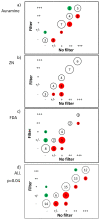A controlled evaluation of filter paper use during staining of sputum smears for tuberculosis microscopy
- PMID: 37766850
- PMCID: PMC10521092
- DOI: 10.12688/wellcomeopenres.18827.1
A controlled evaluation of filter paper use during staining of sputum smears for tuberculosis microscopy
Abstract
Background: Some sputum smear microscopy protocols recommend placing filter paper over sputum smears during staining for Mycobacterium tuberculosis (TB) . We found no published evidence assessing whether this is beneficial. We aimed to evaluate the effect of filter paper on sputum smear microscopy results. Methods: Sputum samples were collected from 30 patients with confirmed pulmonary TB and 4 healthy control participants. From each sputum sample, six smears (204 smears in total) were prepared for staining with Ziehl-Neelsen (ZN), auramine or viability staining with fluorescein diacetate (FDA). Half of the slides subjected to each staining protocol were randomly selected to have Whatman grade 3 filter paper placed over the dried smears prior to stain application and removed prior to stain washing. The counts of acid-fast bacilli (AFB) and precipitates per 100 high-power microscopy fields of view, and the proportion of smear that appeared to have been washed away were recorded. Statistical analysis used a linear regression model adjusted by staining technique with a random effects term to correct for between-sample variability. Results: The inclusion of filter paper in the staining protocol significantly decreased microscopy positivity independent of staining with ZN, auramine or FDA (p=0.01). Consistent with this finding, there were lower smear grades in slides stained using filter paper versus without (p=0.04), and filter paper use reduced AFB counts by 0.28 logarithms (95% confidence intervals, CI=0.018, 0.54, p=0.04) independent of staining technique. In all analyses, auramine was consistently more sensitive with higher AFB counts versus ZN (p=0.001), whereas FDA had lower sensitivity and lower AFB counts (p<0.0001). Filter paper use was not associated with the presence of any precipitate (p=0.5) or the probability of any smear washing away (p=0.6) during the staining process. Conclusions: Filter paper reduced the sensitivity of AFB microscopy and had no detectable beneficial effects so is not recommended.
Keywords: Auramine; Filter paper; Ziehl Neelsen; acid-fast bacilli; fluorescein diacetate; microscopy; sputum smear; tuberculosis.
Copyright: © 2023 Bailon N et al.
Conflict of interest statement
No competing interests were disclosed.
Figures









References
-
- World Health Organization: Global tuberculosis report 2020. 2020. Reference Source
-
- Hooja S, Pal N, Malhotra B, et al. : Comparison of Ziehl Neelsen & Auramine O staining methods on direct and concentrated smears in clinical specimens. Indian J Tuberc. 2011;58(2):72–6. - PubMed
Grants and funding
LinkOut - more resources
Full Text Sources

